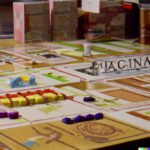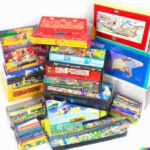Introduction
In the universal spirit of play, meaningful bilingualism can be cultivated through board games. Board games present an exciting new way to engage students in language learning that is structured, fun, and interactive. By introducing bilingual board games as supplemental instructional material, educators have a unique opportunity to foster both language and cultural competencies in a creative form of play.
The potential benefits of incorporating bilingual board games into instruction are vast. Research indicates that children who are exposed to two languages demonstrate higher adaptive behavior and knowledge retention than those who are exposed to just one. Using board games enhances student engagement as well as provides a more meaningful context for understanding language usage”all within an active learning environment that encourages practice while having fun. Students develop critical problem-solving skills during game play in addition to exploring different methods verbal communication such as gesture, body movement, intonation or facial expression etc., which helps learners become more confident with their abilities from the aspects of both linguistic and cultural understanding. In a bilingual classroom setting, instructors have the ability to control variables by determining level of text complexity and subject matter for different levels of learners in order for them to stretch out of their comfort zone without feeling overwhelmed or becoming discouraged.
Moreover, through the incorporation of culturally relevant topics covered within various board games, teachers can help create an inclusive yet safe space for learning where students are encouraged and empowered to share what they know from their culture’s background; a great method for developing communicative competence while establishing relationships built on mutual respect and understanding between individuals with diverse backgrounds. Bilingual board games allow teachers the freedom to tailor instruction specific to the language goals reflected in their curriculum due to its highly customizable setup structure which makes them ideal tools for promoting individualized activities across age demographic groups among single or multiple class settings while meeting cross-curricular objectives simultaneously. Therefore it is overall seen how much potential resides when working with these educational resources; whether used during family activities or being taken further into classrooms numberless grown due involving enhancing elements remain alive brightening our common goal”recurring investment toward mutually advantageous learner centered experiences which result our shiny outlook towards uniting communities at large!
Why Bilingual Board Games?
Bilingual board games are becoming increasingly popular as a fun and interactive way to encourage language acquisition. They provide an exciting, stimulating and engaging platform where players of all ages can interact while learning a new language. The combination of visuals, symbols, questions and answers helps to develop memory recall and recognition in relation to language rules and structure. Through clear communication, thoughtful instruction, story organization, strategic questioning and problem solving skills, bilingual board games nurture the improvement of reading comprehension, grammar knowledge, writing mechanics and most importantly conversational communication skills.
The popularity of bilingual board games is due to their ability to reinforce the fundamentals of both languages simultaneously. Unlike traditional teaching methods that focus on one language at a time for each lesson, these games engage learners by utilizing the native tongue for play activity and learning aids throughout the game. This allows participants to translate components into their native tongue in order to make sense of the game’s rules or objectives. Along with this approach comes a more relaxed atmosphere which allows for natural conversational flow unlike what may have existed during other formal methods of instruction.
Furthermore, bilingual board games do not require additional resources such as textbooks or textbooks to get up-to speed when learning either language; rather they present language skills through enjoyable activities that actually simulate real life experiences so students become acclimated quickly thereby reinforcing useful terms or phrases organically without them having been formally taught in previous classes. In addition to allowing players an opportunity to discover words or facts related to a certain topic as part of the game play experience along with teaching them how different expressions may be used in response depending on the context that phrase or word is used in. All these elements combined foster faster development allowing learners who use bilingual educational aids like board games to reach higher levels before their peers who might’ve been stuck using traditional teaching materials alone.
Types of Bilingual Board Games
Bilingual board games offer an exciting way for language learners of all ages to pick up a new language. Since the inception of these kinds of games, players can explore various gaming platforms such as interactive digital boards, traditional card games, and more. Through playing these board games, participants practice communication skills and learn phrases while having fun with friends. Key components like detailed instructions, colorful visuals, sound effects, and feedback mechanisms make them even more effective in mastering a new language.
The variety of bilingual board games available to players includes phrase-building activities and nation-based trivia competitions involving map reading, predictions on world events, or conversations with other players. By securely connecting players around the globe who speak different languages”often facing barriers presented by spoken dialogue”these board game structures provide the perfect opportunity to create lasting relationships and friendships between individuals from different cultures. Additionally, since many bilingual board game designs use culturally relevant themes and artwork drawn from each participating culture’s history, this type of learning also promotes global awareness about important customs that may differ from players’ current lifestyles. Players also benefit from incorporating diverse topics like sports into their gaming experience since this approach gives them valuable opportunity to comprehend how others play within their respective culture. Finally, recent research has indicated that interacting in virtual communities directly affects attitude formation towards a new language ” accentuating the idea that participating in engaging bilingual board games benefit both language comprehension and relatability towards individual cultures.
Developing Communication Skills with Bilingual Board Games
Bilingual board games are a fun and engaging way to learn a new language. They provide an immersive experience wherein players can develop communication skills in a low-pressure, enjoyable environment. For example, language-games such as Taboo involve players providing word cues in the foreign language to help their teammates guess the designated subject before other teams. This exercise helps foster learning by prompting players to actively practice speaking and listening skills while cheering on their partners.
In today’s globalized world, being able to communicate effectively in multiple languages is essential for success. Bilingual board games are a great tool for developing effective communication skills because they go beyond just soaking up vocabulary words or grammar rules – by requiring certain actions or responses from players, these games gradually train the mind to think in the target language and react quickly with spontaneous replies when having conversations with native speakers. As well as helping with pronunciation, playing bilingual board games develops listening comprehension – by tuning into what others say or guess despite any language barrier. Additionally, participating in bilingual board games encourages teamwork and critical thinking – the need for creative solutions when faced with limited vocabulary can lead to unique conclusions that reveal unexpected ways of expressing ideas across languages.
All of these advantages make bilingual board games an incredibly valuable tool for helping students gain confidence with conversational proficiency in another language. Whether it be during recreational hours at school or fun nights at home where family members play together, incorporating these activities into learning sessions will undoubtedly shine a spotlight on each student’s ever-growing linguistic abilities!
Benefits of Bilingual Board Games
Bilingual board games provide numerous immediate and long-term advantages that can make a significant impact on a person’s life. In the short-term, bilingual board games can help children to expand their language skills quickly and efficiently, as well as aid adults who are looking to increase their fluency in a second language or want to remain proficient in a foreign language they already know. Additionally, these kinds of games foster critical thinking and problem solving skills, as many require players to strategically utilize both languages in order to succeed.
Aside from the immediate benefits of playing bilingual board games, developing a meaningful understanding of two different languages through gameplay has long-term implications that affect the lives of those playing them. Bilingual individuals have better job prospects at multilingual companies, and more opportunities for educational access due to increasing globalization of the world today. Therefore, having the ability to understand dialectal nuances associated with multiple languages helps in connecting with people around the world more deeply since it rectifies communication barriers caused by lack on mutual understanding. It also opens doors for greater vocational opportunities due to potential new career paths encountered outside your native country. Moreover, having an understanding of multiple languages helps break negative stereotypes that are often associated with certain cultures since barriers between communities are made smaller when we all hold a general understanding for one another’s methods of communication!
Finding Quality Bilingual Board Games
Bilingual board games are a great way to learn and practice a second language in an enjoyable, interactive manner. Whether you are looking to pick up conversational Spanish, brush up on your French skills, or develop English fluency in new levels of complexity, there is no better way to do so than through the fun and strategy of select bilingual board games. However, finding quality bilingual board games can be difficult; budgets may be tight, stores may carry limited options, and with our increasingly digital culture often it can be hard to know what you’re getting when making an online purchase. In order to make sure that you get the best bilingual board game for your needs (and budget), here are some key tips:
1. First and foremost, check with local stores. Depending on the area that you live in, stores may carry larger selections than websites”and discovering such a spot could mean deeper discounts than buying online as well as providing an opportunity for hands-on exploration before actually purchasing anything.
2. Next, if searching online for bilingual board games, read customer reviews carefully as they will be some of your most reliable sources of product feedback from people who have used the items themselves; Additionally researching ratings (such as those given by Chess House) can also help guide your purchases and ensure quality control measures have been met internally. 3. Lastly don’t underestimate the power of asking around; teachers or other professionals who work with language learning or language instruction often have insights into the best products for individual learning goals. Through these resources not only might end up finding lesser known bilingual board games but potentially even receiving friend/family discounts!
Conclusion
In conclusion, bilingual board games benefits players not just by allowing them to learn a second language, but also by bringing about an insightful and entertaining experience. The variety of language related game options cater to all ages, thus appealing to people from different backgrounds. Additionally, playing in pairs or with a group of people strengthens relationships and builds creativity. For those interested in using bilingual board games as a form of language learning and entertainment, there are now many choices avaiable on the market. Bilingual board games provide an opportunity for growth while stimulating joy and relaxation in family gatherings. All in all, these experiences bring forth the pleasure of learning through play.

I love playing all kinds of games – from classics like Monopoly to modern favourites like Ticket to Ride.
I created this blog as a way to share my love of board games with others, and provide information on the latest releases and news in the industry.





